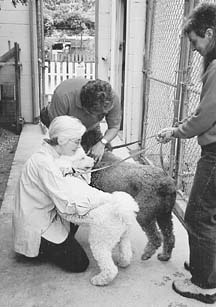Two stunning standard poodles, one pure white, the other charcoal gray, were wandering loose on Santa Cruz’s Seacliff Beach in early June, not far from a busy road.
Jeff, the concerned citizen who corralled the dogs, was dismayed to find they had no tags, so he was unable to return them to their home. He put a “Dogs Found” ad in the newspaper and kept the dogs for three days, sure that someone would be looking for such wonderful animals, but no one called. With some ambivalence, he loaded them into his car and delivered them to the nearby Santa Cruz SPCA. They are obviously well-loved dogs, he reassured himself. They will be safe; the owner will come for them.
As it turned out, taking the dogs to the shelter was the best thing he could have done.

Shelter workers at the SPCA received the dogs, and as is routine for them, passed a microchip scanner over the dogs’ shoulders. One of them elicited a “beep!” from the scanner, and staff told the anxious finder that the dog was “chipped,” so they would likely be able to trace the owner. Relieved, Jeff got in his car and returned home, reassured that he had done the right thing by taking the dogs in.
Back at the shelter, the story was just unfolding. Shelter workers traced the microchip to a breeder in Los Angeles, who told them that the dogs belonged to Margie Takei, in Eugene, Oregon. The breeder’s veterinarian had implanted the chip in Morgan, the white poodle, three years earlier, before she was sold to Takei.
The shelter staff guessed that Takei must have lost the dogs while visiting Santa Cruz, a popular tourist town on the central California coast. But when they contacted the woman in Eugene, they were stunned to hear that the owner was never in Santa Cruz! She had been eating dinner at a Portland restaurant two weeks earlier, while her dogs waited in her Volkswagen camper in the parking lot. At one point during the meal she heard the dogs barking loudly and went out to check on them. Calling them by name, she calmed them down and returned to her meal.
After dinner, she discovered her camper was gone. Stolen! With her beloved dogs inside. Frantic, she reported the theft, posted flyers all over Eugene and Portland, and notified Oregon shelters to be on the lookout. But after two weeks, she was beginning to despair of ever seeing her dogs again.
Then came the phone call. Her dogs were safe and waiting for her at the Santa Cruz SPCA. Thanks to the microchip, her beloved Morgan and Sagan came home.
Worst Nightmare
Losing a canine companion is a responsible dog owner’s worst nightmare. We go to great lengths to ensure our dogs’ safety. We leash them, fence them, keep them indoors, or close to our sides. Yet accidents happen. A door doesn’t close tightly. The meter reader leaves the gate open. A section of fence falls down in a windstorm, flood, or earthquake. We’re in a car accident and our dog panics, jumps through the broken windshield and runs off. While safe, appropriate confinement is a critical first-line defense against pet loss, proper identification is your lost dog’s ticket home when the first line fails.
But which kind of identification? There are actually just three primary types of identification for dogs – ID tags, tattooing, and microchips – and each has advantages and disadvantages.
ID Tags
Most citizens who find a dog will promptly contact the owner and return the dog home if they can. An ID tag gives the finder immediate information and facilitates a speedy reunion, saving a trip to the nearest animal shelter and forestalling hours or days of anxious searching by the owner. A license can do the same after one quick call to animal control to get owner information. Many animal control agencies also have a policy of trying to return a dog home rather than impounding him, if he is wearing a current license or ID. Since most agencies charge impound and board fees to reclaim impounded animals (fees can sometimes exceed $100), the ID tag can also save an owner anxiety and money, by preempting a costly trip to the shelter.
There is a wide variety of ID tags to choose from, and it probably doesn’t matter which you use, as long as you use one of them. Temporary paper-and-plastic tags can be filled out with a permanent marker and then sealed, allowing for instant security. You can send away for fancy engraved tags that will never fade or suffer water damage. There are even “talking” ID tags that play a recorded message to your dog’s rescuer.
Because tags provide potential for the quickest trip home for your dog, most shelter officials vehemently urge that dogs wear ID tags and licenses at all times, as the mainstay of an identification program, even when the dog is safe at home.
Make your choice based on your and your dog’s needs – immediacy, durability and fashion statement – and then consider the added protection of the two backup methods of ID, because the ID tag is not the perfect solution. Tags and collars can fall off, or can be removed by unfriendly people, as was the case with the Poodles.
Also, some owners don’t like to use them due to the annoyance of the jingling of tags as the dog moves around, or scratches at an errant flea. While the annoyance seems minor in comparison to the trauma of losing a dog, an easy solution to this complaint is to tape or rivet the tags flat against the collar, or to buy a flat leather collar to which a flat ID tag is riveted.
Tattoos
Tattooing takes the collar ID concept one step further, by giving the dog a form of un-removable (and silent!) identification. It involves the injection of ink under the dog’s skin with an electronic pen. When the tattoo technician “writes” with the pen, a tiny needle injects the ink to a depth of 1/32 of an inch under the skin, in a series of numbers or letters. According to Julie Muscove, founder and executive director of Tatoo-A-Pet, the procedure is quick and painless.
“We sell the system to veterinarians, groomers, breeders, and other authorized agents, at a cost of about $250,” she says.” Although it doesn’t require the use of anesthesia, most vets will anesthetize the dog because they find it easier to work on a stationary target than a moving one. So the cost of tattooing may range from $20 from an authorized agent (who doesn’t anesthetize) to more than $100 from some veterinarians.”
Tattoos are usually placed on the bare skin inside a dog’s flank, or sometimes, as in the case of racing greyhounds, in the dog’s ear. Tattoos cannot be lost or removed, and they are pretty durable, although someone can alter a tattoo if they are determined. (Horror stories of greyhounds having their tattooed ear cut off and then being abandoned have sickened the dog world gossip circuit; for this reason alone, Tatoo-A-Pet does not recommend tattooing the ears.) Tattoos can be a great way to prove ownership in a custody or identity dispute, and laboratories are generally leery of doing research on tattooed dogs without first tracing ownership.
The tattoo dilemma has to do with what you choose to write. In today’s transient society, a phone number is no good; a person might move several times in their dog’s life, or area codes can change. Some owners tattoo their pets with their Social Security number (SSN) or driver’s license number, but these, too, are problematic. For security reasons, neither Social Security nor state drivers’ licensing officials will release a person’s address or phone number. Local police departments and city animal shelters which are affiliated with the local police departments can access driver’s license information and contact the owners, but they cannot trace Social Security numbers.
Registering tattoos
There are at least two national dog tattoo registries that can facilitate tattoo tracing, but finding an owner can still be a frustrating proposition, since not all owners registers their dogs’ tattoos with one of or both of these two groups (and over the years some tattoo registries have come and gone).
The companies are aware of the system’s shortcomings, and they do what they can to overcome them. Tatoo-A-Pet, which has been in operation for 26 years, will help trace any tattoo, not just the ones that are registered with them. To make the registration attractive to owners, they charge just $10 to register a tattoo for each pet’s lifetime, or a one-time $25 fee for a multiple-pet household. Company officials claim a have a 99 percent tattoo recovery success rate. (See “Resources,” page 24, for contact numbers for Tattoo-A-Pet and all other pet identification companies mentioned in this article.)
Another leading tattoo registry, the National Dog Registry, helps people find qualified tattoo technicians in their area, and will register any letter or number combination, but suggests that their clients lead the chosen combination with “NDR.” Of course, this approach depends on recognition of the NDR initials and name.
Petfinders is another dog-registration company that has made a specialty out of registering dog descriptions. While the presence of a tattoo certainly aids the description that the company will enter in their database of dog descriptions, they will also register dogs without tattoos.
If you have a purebred dog, the American Kennel Club recommends tattooing it with its AKC registration number. The Club has established a unit, the Companion Animal Recovery, that will assist a registered dog become reunited with its rightful owner. Critics of the Club (this includes the commercial tattoo registries, of course) allege that the Club’s records on owners’ names, addresses, and phone numbers are notoriously out of date and incomplete, and can be next to useless.
A final frustration is that most shelters don’t routinely roll incoming dogs onto their backs to look for tattoos. Many dogs don’t take kindly to being rolled on their backs by a stranger, especially in the high-stress environment of an animal shelter, and shelters are understandably reluctant to risk bites to staff from dogs who protest the procedure. However, most shelters, but by no means all, will make an effort to look for tattoos immediately prior to euthanasia, if a dog will tolerate the search.
Microchipping
The third dog identification option is microchipping, also known as “radio frequency identification.” The high-tech member of the dog ID team has been available commercially for companion animal identification since 1988.
The microchip is a tiny computer chip etched with an identification code. The chip is attached to an antenna and encased in surgical-grade glass to form a transponder, or tag. The transponder is about the size of a grain of rice, and when injected under the skin between a dog’s shoulder blades, is unnoticeable on all but the smallest and most short-haired dogs. The injection process takes only a few seconds, requires no anesthesia, and is no more painful for a pet than a vaccination.
A special receiver is used to “read” the chip’s transponder by use of a tiny radio frequency signal. Shelter staff scanning a lost pet can use the code to locate the owner of the animal, or to retrieve any other information stored in the system’s database. The life expectancy of the chip is 20 to 25 years, and the cost of chipping is affordable to most pet owners – from $15 at some animal shelters, to $50 or more at veterinary hospitals, with an additional cost for lifetime registration in some system databases.
A permanent, unalterable method of pet identification sounds almost too good to be true, and of course, it is. The “Big Brother” aspect of microchipping makes some people uncomfortable. Some holistic veterinarians and owners cringe at the idea of permanently injecting a foreign object, albeit a tiny one, under the dog’s skin. (However, there is no documented evidence to show that chips present any kind of health risk to dogs.)
More significant are the kind of drawbacks that challenge the efficacy of the tattoo system. Not all shelters scan for chips, so some chip companies offer a visible ID tag to alert finders that the pet is chipped. Of course, the tag can be lost or removed. It is also possible to miss a chip while scanning, although over the last decade the quality of scanners has improved. Fractious animals can be difficult to scan. Microchip manufacturers are working to invent newer, better technology that will make chips easier to scan and read from greater distances.
Infighting slows progress
But perhaps the most serious downside on the microchip scene is the squabbling between the three major players in microchip marketing. Destron manufactures the “Home Again” chip, which is marketed to veterinarians through Scheuring-Plough. Destron’s database is kept by the AKC’s Companion Animal Recovery division. Avid markets their own microchip and maintains their own database. InfoPet initially marketed the Destron chip, but now sells the Trovan chip, manufactured in Europe, and also maintains their own database.
Lawsuits and accusations between the companies over proprietary information abound, which gives rise to concerns about the stability and longevity of the various companies and their registration systems. The infighting has also slowed the progress toward universally compatible systems, much to the detriment of lost pet recovery. If shelter staff doesn’t have access to all three scanners, they may find themselves unable to access the necessary information, even if they know a chip is present in a dog. Although at least one company claims to have a “universal” scanner that reads all three companies’ chips and the others report that theirs will at least identify the presence of another chip, the reliability of the scanners reportedly declines when they are used to scan for chips other than their own.
If your local shelters have a well-developed chipping program (as is the case in many parts of California), then this method may be a viable element of your dog identification package. In 1989, the Marin Humane Society, in Novato, California, became the first shelter in the country to microchip all of their adoption dogs and cats; the shelter now also offers chipping services to the general public at an extremely low cost. Shelter staff say they recover close to 200 microchipped dogs each year, many of whom are not wearing any other form of identification, despite the fact that every adoption animal leaves the shelter wearing a physical ID tag.
The ID Answer?
The best approach to identification is to cover all the bases. Certainly, all pets should wear ID tags at all times, not just when they are out for a walk. But in the event that tags are lost or removed, a back-up tattoo and/or a microchip, especially if they are registered with one or more registries, can literally mean the difference between life and death for your missing pet.
“We recommend using all three methods,” says Kat Brown, Director of Operations for the Santa Cruz SPCA. “A regular ID tag is most helpful for the finder. A chip is great back-up when you have shelters and vets in your area that scan. And a tattoo is triple insurance.”
Or, in other words, why not give your dog two or three tickets home? Margie Takei, the Poodle owner mentioned at the beginning of this article is glad she did.
“I knew Morgan was microchipped,” she says, “but I didn’t understand what it meant – I just thought it was something the breeder did for her records. Believe me, I understand now. All of my pets in the future will always be microchipped.”
-By Pat Miller
Pat Miller is a regular contributor to WDJ. A freelance writer and dog trainer, she lives in California.





